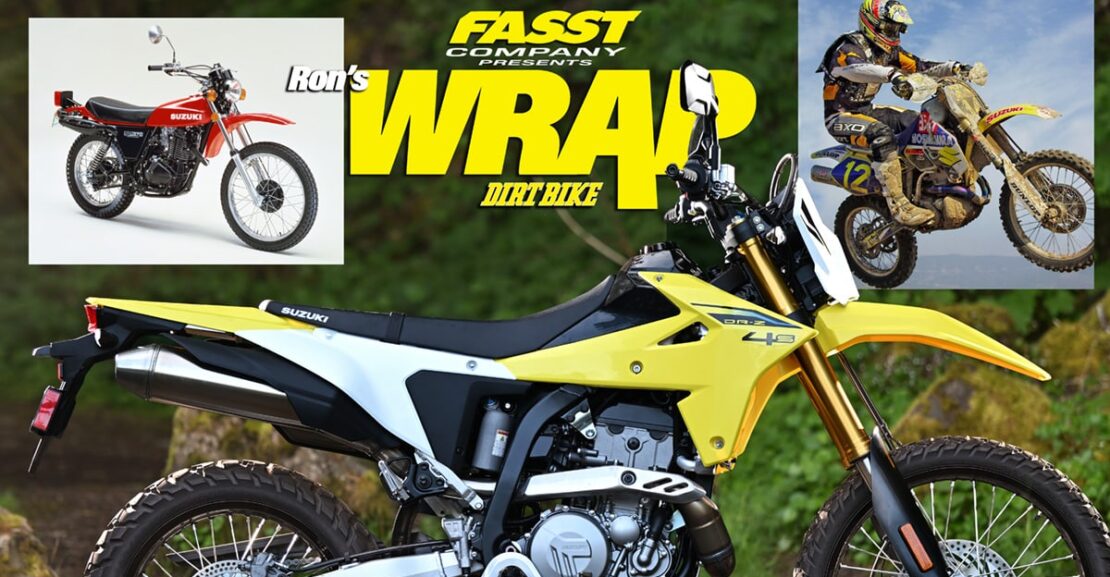For Suzuki, the arrival of a new dirt-oriented model is big news. This is, after all, a company that wears kickstarters like a badge of honor. The world press descended on Portland, Oregon three weeks ago for a massive introduction in the Tillamook State Forest. Suzuki was proud of the new DR-Z. This is more than an updated version of the old one with fuel injection to meet current emission standards. Every part is new, from the twin spark plug head to the perimeter frame.
But when you ride the bike, you still know where it came from. Despite the new technology, despite the redesigned parts, despite the infusion of electronics, this is a direct descent of the DR-Z400S, and its heritage shows through. The riding position feels more modern, the bike is slimmer and the seat/tank junction is less abrupt. But, the handling and power delivery are classic DR-Z. That’s not so bad. Suzuki says it makes 37.5 horsepower at 8000 rpm which sounds about right and that’s how we remember the original. There’s a big difference in how far that power carries, though. This one keeps on revving on top and the torque starts much earlier down low.
The biggest single handicap for the previous version was that CV carburetor. It had a floating slide that would bounce up and down in the rough stuff making the bike hiccup and stutter. This one has none of that. It’s clean from bottom to top. And down low it has none of the herky-jerky throttle response that’s typical of bikes that were retrofitted with fuel-injection. The DR-Z4S rolls on smoothly down low and doesn’t stall. That last point is important because first gear is very tall. Suzuki didn’t do anyone any favors by keeping the five-speed gearbox. First is high and fifth is low.
In Oregon the trail was absolutely beautiful. There were cool little creeks and every shade of green that you can think of. It was a little dry and rocky, though. It made for a good opportunity to test the Suzuki Ride Mode selector. Between Modes A, B and C, A is said to be the most aggressive. We found it worked better for everything we did. Modes B and C might be appropriate for a true beginner or someone who is new to the dirt. Suzuki’s Traction Control System, on the other hand, offers something very useful that no other dual-sport bike has. Gravel mode. That’s one of the three levels. Modes one and two are mainly for the street or for riding in the rain, but Mode G is surprisingly useful. When you try to drift the rear wheel on a loose rocky road, it lets you kick out the rear end just a little. And, when it starts to go too far, the power is gently rolled back. This isn’t one of those drastic throttle chops that we have seen on so many adventure bikes.
As far as overall handling goes, the DR-Z4S is a little handcuffed by the tires. The IRC Trail Winner tires are very street-oriented. When you couple that with a bike that weighs over 300 pounds, there’s only so much you can do. Having said that, the DR-Z4S could still manage a pretty impressive clip in the tight stuff. You can read the full test of the DR-Z4S in the August, 2025 print edition of Dirt Bike.
DR-Z HISTORY
The Suzuki DR-Z400S was a good investment. In its first year of production, it sold for $5349. For the next 25 years, the only thing that changed about the DR-Z was the price. Riders could, in theory, get a new DR-Z each year with the resale money from the previous one.
Right from the start, it was designed to be a trail bike and, in its “S” configuration, a dual-sport, not a competition bike. Racers had other ideals The Yoshimura Suzuki Off-Road team built some very fast racers. With Mike Kiedrowski, the DRZ captured the 2002 and 2002 WORCS championships.
When the Suzuki RM-Z450 arrived, the racing career for the DR-Z was officially over. The off-road version of the bike vanished, leaving the dual-sport DR-Z400S in a more easily understood role. It finally got to be what it was meant to be; the dual-sport bike to have if you didn’t want to go racing. That’s a role that Suzuki knew well, where the company had been a player since the inception of the street-legal off road bike. Here’s the path that the new DR-Z4S took to arrive here today.
Mike Kiedrowski scarcely retired from motocross when Team Suzuki’s Off-road Manager Mike Webb made him an offer he couldn’t refuse. The result was two consecutive WORCS championships on the DR-Z400.
Yamaha is entitled to the credit it gets for the 1968 DT-1, which is the grandfather of today’s dual-sport category. In 1969, however, the Suzuki TS250 Savage arrived. Cycle Magazine compared all the 250s of the day and declared the Suzuki the best.
Prior to 1977 Suzuki made only two-strokes. The first four-stroke dual-sport bike was the 1978 SP370.
In 1990, Suzuki unveiled the air-cooled DR350 and DR250. Both were available as full-time dirt bikes as well as dual-sport bikes. Randy Hawkins agreed to ride a modified DR350 in the ISDE that year and struggled. It was decidedly outside of the bike’s comfort zone.
When the first DR-Z400 arrived, Dirt Bike Magazine test rider Mark Tilley campaigned a modified DR-Z440 in the AMA Four-Stroke Championship. He liked it until he rode his first YZ400F.
For a short time, the DR-Z family included a DR-Z250.
The DR-Z was red meat for the aftermarket. Gary Jones worked at White Brothers in the glory years of the DR-Z.
See you next week!

